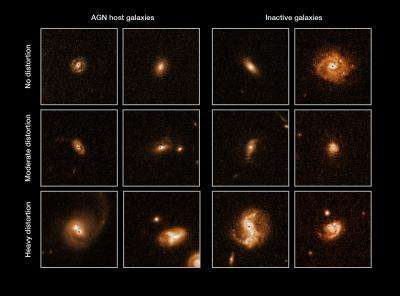Identity parade clears cosmic collisions of the suspicion of promoting black hole growth

(PhysOrg.com) -- What happens when galaxies crash together? For years, these cosmic collisions have been blamed for triggering violent outbursts at the hearts of galaxies. Now, a remarkable piece of detective work has given a verdict: galactic mergers do not usually whet the appetite of the black holes that power these active galactic nuclei, meaning other, less dramatic phenomena are responsible.
Most galaxies, including our own, have a huge but well-behaved black hole at their heart, while some have messy eaters that suck in vast amounts of matter which then shines brightly as it falls towards oblivion. This causes the telltale bright spots at the centre of galaxies known as active galactic nuclei (AGN). Why are the two types so different? Until now, the leading theory has been that mergers between galaxies are instrumental in driving matter into the black holes, making them grow.
In a new study, the largest of its kind so far, astronomers set up an identity parade of galaxies to test this theory. Comparing 140 active galaxies with a control group of over 1200 comparable inactive galaxies, they found that there has been no significant link between AGN activity and galactic mergers for at least the past eight billion years. Therefore, other phenomena such as instabilities within galaxies, collisions of molecular clouds or tidal disruption by other galaxies flying by must instead be to blame.
The results will be published in the Astrophysical Journal on 10 January.
The emission of radiation from active galactic nuclei is driven by the behaviour of matter such as gas clouds and even stars as it heats up and falls into the galaxy's supermassive central black hole. But an open question in the physics of active galaxies is precisely how matter crosses the final few hundreds of light-years to reach the immediate neighbourhood of the black hole before being swallowed.
Team leader Mauricio Cisternas from Germany's Max Planck Institute for Astronomy explains: "A study of this scope has become possible only recently, as the large surveys undertaken using the Hubble Space Telescope have become available. These have given us a huge sample of galaxies, both active and inactive, meaning that we can now study many distant galaxies in exquisite detail. Before these surveys, we hadn't examined many active galaxies at large cosmic distances in sufficient detail."
Cisternas and his team chose 140 active galaxies from the COSMOS survey. The COSMOS field is an area of sky roughly 10 times the area covered by the Moon, in the constellation of Sextans (the Sextant), which has been comprehensively mapped by Hubble and other telescopes at different wavelengths. It contains several hundred thousand distant galaxies of all types. The team was able to identify active galaxies from among these using X-ray observations from ESA's XMM-Newton space telescope, and they then studied the more detailed optical images of them taken by the NASA/ESA Hubble Space Telescope.
For each of the active galaxies in the study, they selected nine non-active galaxies at roughly the same distances, and thus roughly in the same stage of cosmic evolution, from the same Hubble images. This gives a grand total of just over 1400 galaxies that the team could then test for the telltale signs of mergers.
"You can usually tell when galaxies have been involved in a merger," explains Knud Jahnke, co-author of the study. "Instead of the neat, geometric spiral or smooth elliptical shapes you usually see in Hubble images, colliding galaxies typically look distorted and warped. We planned to find out whether these misshapen galaxies were more likely than regular ones to host active nuclei."
Identifying whether or not a galaxy is distorted is a matter of judgement for which the expert eye of a trained astronomer is far better than any computerised assessment. To harness this human expertise without introducing the risk of unwitting bias, Cisternas set up a kind of identity parade of galaxies, in which he had modelled and removed the bright spot that reveals the AGN. Ten galaxy experts, based at eight different institutions, independently assessed whether each of the galaxies was distorted or not, without being told which had an AGN.
None of the experts found a significant correlation between a galaxy's activity and its distortion, that is, between its black hole being well-fed and its involvement in a major merger.
While mergers are a common phenomenon, and are thought to play a role at least for some AGN, the study shows that they provide neither a universal nor a dominant mechanism for feeding black holes. By the study's statistics, at least 75%, and possibly all, of AGN activity over the last eight billion years must have a different explanation. Possible ways of transporting matter towards a central black hole include instabilities of structures like a spiral galaxy's bar, the collisions of giant molecular clouds within the galaxy, or the fly-by of another galaxy that does not lead to a merger (known as galactic harassment).
Could there still be a causal connection between mergers and activity in the more distant past? That is the next question the group is gearing up to address. Suitable data is bound to come from two ongoing observational programmes (Multi-Cycle Treasury Programs) with the Hubble Space Telescope, as well as from observations by its successor, the James Webb Space Telescope, which is scheduled for launch after 2014.
Provided by ESA/Hubble Information Centre


















